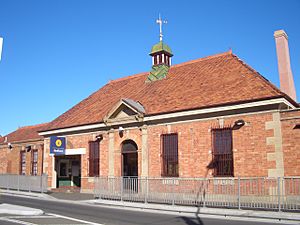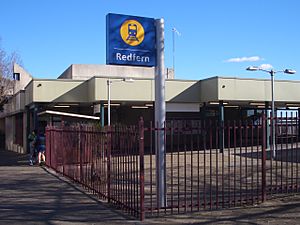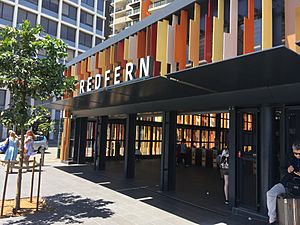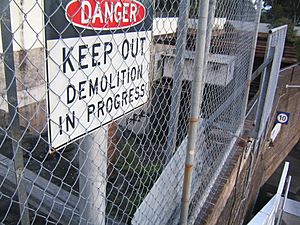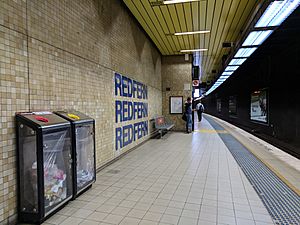Redfern railway station facts for kids
Quick facts for kids
Redfern
|
|||||||||||||||||||||||||||||||||||||||||||||||||||||||||||||
|---|---|---|---|---|---|---|---|---|---|---|---|---|---|---|---|---|---|---|---|---|---|---|---|---|---|---|---|---|---|---|---|---|---|---|---|---|---|---|---|---|---|---|---|---|---|---|---|---|---|---|---|---|---|---|---|---|---|---|---|---|---|
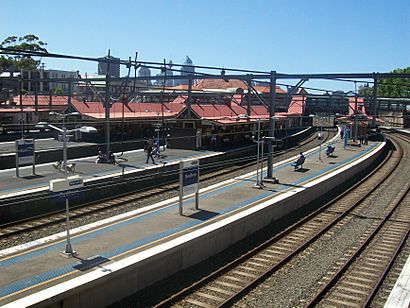
Northbound view from Platform 10 in October 2011
|
|||||||||||||||||||||||||||||||||||||||||||||||||||||||||||||
| Location | Lawson Street, Redfern | ||||||||||||||||||||||||||||||||||||||||||||||||||||||||||||
| Coordinates | 33°53′31″S 151°11′55″E / 33.89202°S 151.19873°E | ||||||||||||||||||||||||||||||||||||||||||||||||||||||||||||
| Owned by | Transport Asset Holding Entity | ||||||||||||||||||||||||||||||||||||||||||||||||||||||||||||
| Operated by | Sydney Trains | ||||||||||||||||||||||||||||||||||||||||||||||||||||||||||||
| Line(s) |
|
||||||||||||||||||||||||||||||||||||||||||||||||||||||||||||
| Distance | 1.3 kilometres (0.81 mi) from Central | ||||||||||||||||||||||||||||||||||||||||||||||||||||||||||||
| Platforms | 12 (2 side, 5 island) | ||||||||||||||||||||||||||||||||||||||||||||||||||||||||||||
| Tracks | 12 | ||||||||||||||||||||||||||||||||||||||||||||||||||||||||||||
| Connections | Bus | ||||||||||||||||||||||||||||||||||||||||||||||||||||||||||||
| Construction | |||||||||||||||||||||||||||||||||||||||||||||||||||||||||||||
| Structure type |
|
||||||||||||||||||||||||||||||||||||||||||||||||||||||||||||
| Disabled access | Yes, platform 6-7 only | ||||||||||||||||||||||||||||||||||||||||||||||||||||||||||||
| Architect | John Whitton | ||||||||||||||||||||||||||||||||||||||||||||||||||||||||||||
| Architectural style | Federation Queen Anne | ||||||||||||||||||||||||||||||||||||||||||||||||||||||||||||
| Other information | |||||||||||||||||||||||||||||||||||||||||||||||||||||||||||||
| Status | Staffed | ||||||||||||||||||||||||||||||||||||||||||||||||||||||||||||
| Station code | REF | ||||||||||||||||||||||||||||||||||||||||||||||||||||||||||||
| Website | Transport for NSW | ||||||||||||||||||||||||||||||||||||||||||||||||||||||||||||
| History | |||||||||||||||||||||||||||||||||||||||||||||||||||||||||||||
| Opened |
|
||||||||||||||||||||||||||||||||||||||||||||||||||||||||||||
| Electrified | Yes | ||||||||||||||||||||||||||||||||||||||||||||||||||||||||||||
| Previous names | Eveleigh | ||||||||||||||||||||||||||||||||||||||||||||||||||||||||||||
| Traffic | |||||||||||||||||||||||||||||||||||||||||||||||||||||||||||||
| Passengers (2018) | 23,070 (daily) (Sydney Trains, NSW TrainLink) | ||||||||||||||||||||||||||||||||||||||||||||||||||||||||||||
| Rank | 6 | ||||||||||||||||||||||||||||||||||||||||||||||||||||||||||||
|
|||||||||||||||||||||||||||||||||||||||||||||||||||||||||||||
| Official name | Redfern Railway Station group; Tenterfield railway | ||||||||||||||||||||||||||||||||||||||||||||||||||||||||||||
| Type | State heritage (built) | ||||||||||||||||||||||||||||||||||||||||||||||||||||||||||||
| Designated | 2 April 1999 | ||||||||||||||||||||||||||||||||||||||||||||||||||||||||||||
| Reference no. | 1234 | ||||||||||||||||||||||||||||||||||||||||||||||||||||||||||||
| Type | Railway Platform/ Station | ||||||||||||||||||||||||||||||||||||||||||||||||||||||||||||
| Category | Transport - Rail | ||||||||||||||||||||||||||||||||||||||||||||||||||||||||||||
| Builders | Department of Railways | ||||||||||||||||||||||||||||||||||||||||||||||||||||||||||||
Redfern railway station is a very old and important train station in Sydney, Australia. It's located in the inner-city suburb of Redfern. The station is special because it's listed as a heritage site, meaning it has historical importance.
It was designed by John Whitton and built by the Department of Railways. The station first opened on 26 September 1855, but it was known as Cleveland Fields back then. Today, Redfern Station is used by almost all Sydney Trains lines and some longer-distance NSW TrainLink services.
Contents
Station History
How Redfern Got Its Name
The area where Redfern is today used to have sand hills and swamps. The Cadigal people, who lived here first, found lots of food in this area.
The name Redfern comes from William Redfern, who received land here in 1817. He was a surgeon who had a difficult past but became very important in early Sydney. He even helped improve conditions on convict ships.
In 1817, William Redfern was given about 100 acres (40 hectares) of land. This land is now the suburb of Redfern. He built a large country house there with beautiful gardens.
Later, in 1849, a new law made businesses like slaughterhouses move out of the city. Many of these businesses, like tanneries, moved to Redfern and Waterloo. This was because these areas had good access to water. By the late 1850s, Redfern was a busy suburb with 6,500 people.
Redfern became its own local area (municipality) in 1859. The Redfern Town Hall opened in 1870.
The Railway Station's Journey
The very first Sydney railway station was built in 1855. It was in an area called Cleveland Fields, which is now part of the railway lines near Redfern. This first station was simple, with one wooden platform. It was often called 'Redfern' station, which can be confusing!
In 1874, a new brick station with two platforms replaced the original one. This second station was designed to handle more trains. However, it was still a bit far from the city centre.
So, a brand new station, the current Sydney Central station, was built closer to the city. It opened in 1906. The old 1874 station was then taken down.
Meanwhile, a station called Eveleigh opened in 1876, about 1.3 km (0.8 miles) west of the original 'Redfern' station. In 1885, Eveleigh's platforms were rebuilt at the current Redfern site. On 21 October 1906, this Eveleigh station was officially renamed Redfern. This happened when the main Sydney station became 'Central'.
Redfern Station became very important for workers. By the 1940s, many factory workers in Sydney worked near Redfern Station and used the trains to get there.
Station Changes Over Time
The station was first built with three island platforms. An island platform has tracks on both sides. The ticket office was on Lawson Street.
John Whitton, a key engineer for NSW Railways, oversaw the station's construction. The station grew over the years. More platforms were added in 1891-92, 1919, and 1924-25 to handle more trains.
In 1913, a footbridge was built at the southern end. This allowed workers to easily get to the Eveleigh railway workshops from the station.
In 1926, two more platforms (9 and 10) opened as part of the plan to electrify the Illawarra line.
Work on underground platforms (11 and 12) started in the 1940s. But they weren't finished until 1979 when the Eastern Suburbs railway line opened. Original plans for the underground section included more lines that were never built. This is why you can still see unfinished platforms and tunnels above platforms 11 and 12.
The old footbridge at the southern end was removed around 1994. This was because the Eveleigh workshops were closing, and the bridge was no longer needed.
Around 1999, the station had a big upgrade. A new footbridge and stairs were built at the northern end.
In 2004, the station was damaged by fire. The ticket area and station master's office were affected. The windows were later replaced with glass.
People were concerned about the lack of access for people with disabilities. After a large petition, a lift was finally opened for platforms 6 and 7 in November 2015.
The Gibbons Street exit was replaced by a new entrance in November 2018. More improvements for accessibility were planned in 2019, including a new concourse at the southern end.
Station Layout
Redfern Station has 12 platforms. Ten platforms are above ground, and two are underground. The above-ground platforms are connected by stairs to the main concourse on Lawson Street. The underground platforms are connected by stairs and escalators to the Gibbons Street concourse. Both concourses are linked, so you can move between them.
The main station offices, toilets, and train information boards are near the Lawson Street entrance.
When the underground platforms (11 and 12) were built, there were plans for up to four underground platforms. Only two were completed. You can still see parts of the unfinished platforms and tunnels above platforms 11 and 12.
Platforms and Services
| Platform | Line | Stopping pattern | Notes |
| 1 |
CCN
|
morning peak services to Central | |
|---|---|---|---|
|
BMT
|
morning peak services to Central | ||
|
SCO
|
services to Central | ||
|
T7
|
special event services to Central | ||
| 2 |
CCN
|
evening peak services to Gosford, Wyong & Newcastle via Strathfield | |
|
BMT
|
evening peak services to Springwood, Katoomba, Mount Victoria & Lithgow | ||
|
SCO
|
services to Kiama | ||
|
T7
|
special event services to Olympic Park | ||
| 3 | services to Hornsby & Berowra via Gordon | ||
| services to Gordon | |||
|
CCN
|
evening peak services to Gosford & Wyong via Gordon | ||
| 4 | services to Richmond & Emu Plains | ||
| services to Hornsby via Strathfield | |||
| 5 | services to Central & the City Circle | ||
| 6 | services to Homebush, Leppington and Parramatta | ||
| 7 |
T8
|
morning peak services to Central & the City Circle | |
|
T3
|
services to Central & the City Circle | ||
| 8 |
T8
|
evening peak services to Macarthur via Sydenham & East Hills | |
|
T3
|
services to Lidcombe & Liverpool via Bankstown | ||
| 9 |
T3
|
Weekday services to Central & the City Circle commencing from Redfern | |
| 10 |
T3
|
terminating services from Central | |
| 11 |
T4
|
services to Bondi Junction | |
|
SCO
|
services to Bondi Junction | ||
| 12 |
T4
|
services to Cronulla, Waterfall & Helensburgh | |
|
SCO
|
services to Wollongong, Port Kembla, Dapto & Kiama | ||
| 13 / 14 | incomplete platforms situated west of Platforms 11 & 12 and behind Platform 10 |
Station Buildings and Features
Redfern Station has several interesting buildings and features. These include:
- an Overhead Booking Office from 1892
- a waiting room on Platform 1 from 1884
- other offices and stores from around 1884
- five station buildings on Platforms 1 to 10 from 1912
- the underground Eastern Suburbs Railway (ESR) Platforms 11–12 from 1979
Overhead Booking Office
This building, built in 1892, is the main entrance and ticket office. It's made of brick in a style called Federation Queen Anne. It has a tiled roof with a central dome. The main entrance from Lawson Street has an arched doorway with sandstone columns.
Inside, you'll find the ticket office and other staff rooms. Electronic ticket gates lead to the overhead walkway. This walkway connects to all the platforms.
Waiting Room
The brick waiting room on Platform 1 was built in 1884. It has a U-shape with enclosed ends. There's an open waiting area with a timber bench seat between the ends. It has a corrugated iron roof and chimneys. The windows have special arched designs.
Platform Buildings
Most of the island platforms (2-9) and Platform 10 have similar station buildings. These were built in 1912. They are made of brick with special decorative features. They have gabled metal roofs that extend to form awnings, providing shelter for passengers. These awnings are supported by cast iron brackets. Many of the original timber windows are still there.
Underground Platforms
Platforms 11 and 12 are underground. They were completed in 1979 as part of the Eastern Suburbs Railway. You can reach them using stairs or escalators from street level. The walls in the underground area are tiled, and the station name is displayed in blue letters.
Other Features
- Platforms: The station has 12 platforms. Platforms 1-10 are made of brick with a bitumen surface. Platforms 11 and 12 are concrete.
- Lawson Street Overbridge: This bridge, built in 1891, carries Lawson Street over the train tracks at the northern end of the station.
- Air Vents: On Platform 1, you can see four brick air vents or chimneys. These are for an underground line that allowed steam engines to move between Central Station and the Eveleigh Maintenance Centre.
- Unfinished Tunnels: Above Platforms 11 and 12, you can see steelwork for an unfinished platform. There are also unfinished tunnels that show plans for extensions that were never completed.
- Footbridge: The main footbridge and stairs to the platforms were upgraded in 1999. It has a covered area and glass viewing sections. On Platform 1, you can still see two old decorative cast iron posts. These are all that remain from the original fancy iron stairway.
Station Condition
Most of the station buildings, including the main booking office and the underground platforms, are in good condition. Some disused tunnels and steelwork show rust, and one tunnel had to be filled in.
Redfern Station has been changed and updated many times over the years. However, it still looks much like it did in the past. The platform buildings and the main booking office are especially well-preserved.
Accessibility and Exits
Redfern Station has three main exits:
- The main entrance on Lawson Street (Exit A).
- A second entrance on Gibbons Street, especially for platforms 11 and 12 (Exit B).
- A third exit to the Australian Technology Park, accessed from Platform 10 (Exit C).
In 2015, a lift was added to platforms 6 and 7 to make the station more accessible for everyone.
Transport Connections
Redfern Station doesn't have a direct bus interchange. However, there are bus stops nearby on Gibbons Street that serve several bus routes. These buses connect Redfern to areas like Westfield Eastgardens, Mascot, Sans Souci, and Marrickville. There are also NightRide bus services for late-night travel.
Heritage Importance
Redfern Railway Station is very important to the history of New South Wales. It's a major suburban station that helped the nearby areas of Redfern, Darlington, and Chippendale grow.
The Overhead Booking Office is a rare example of the Queen Anne style of railway architecture. It's one of only a few left in Sydney. The station buildings on platforms 2-10 are also special because they are the largest group of their kind in the railway system. This shows how important Redfern was as a hub for commuters and for its connection to the Eveleigh workshops.
The station's growth, with new platforms and the Eastern Suburbs Railway, shows how the Sydney train network expanded over time. Unique features like the air vents on Platform 1 show its connection to the nearby Eveleigh railway yards.
The station is also linked to John Whitton, a very important engineer who helped build the NSW Railways.
Redfern Station is a great example of late 19th-century suburban railway development. It continues to be a major station for commuters in Sydney.
Images for kids


